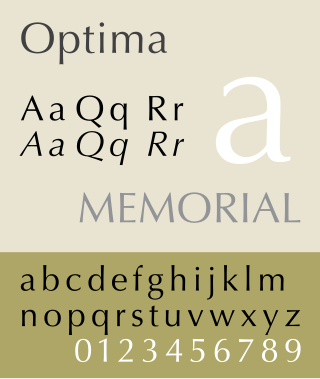
Optima is a humanist sans-serif typeface designed by Hermann Zapf and released by the D. Stempel AG foundry, Frankfurt, West Germany in 1958.

The Wire is a British music magazine publishing out of London, which has been issued monthly in print since 1982. Its website launched in 1997, and an online archive of its entire back catalog became available to subscribers in 2013. Since 1985, the magazine's annual year-in-review issue, Rewind, has named an album or release of the year based on critics' ballots.

Ephram Edward Benguiat was an American type designer and lettering artist. He designed over 600 typefaces, including Tiffany, Bookman, Panache, Souvenir, Edwardian Script, and the eponymous Benguiat and Benguiat Gothic.
The Evergreen Review is a U.S.-based literary magazine. Its publisher is John Oakes and its editor-in-chief is Dale Peck. The Evergreen Review was founded by Barney Rosset, publisher of Grove Press. It existed in print from 1957 until 1984, and was re-launched online in 1998, and again in 2017. Its lasting impact can be seen in the March–April 1960 issue, which included work by Albert Camus, Lawrence Ferlinghetti, Bertolt Brecht and Amiri Baraka, as well as Edward Albee's first play, The Zoo Story (1958). The Camus piece was a reprint of "Reflections on the Guillotine", first published in English in the Review in 1957 and reprinted on this occasion as the magazine's "contribution to the worldwide debate on the problem of capital punishment and, more specifically, the case of Caryl Whittier Chessman." The magazinne's commitment to the progressive side of the political spectrum has been consistent, with early stance for civil rights and against the Vietnam War. The image of Che Guevara that first appeared on the cover of its February 1968 issue, designed by Paul Davis and based on a photograph by Alberto Korda, became a popular symbol of resistance.

Leo Lionni was an Italian-American writer and illustrator of children's books. Born in the Netherlands, he moved to Italy and lived there before moving to the United States in 1939, where he worked as an art director for several advertising agencies, and then for Fortune magazine. He returned to Italy in 1962 and started writing and illustrating children's books. In 1962, his book Inch by Inch was awarded the Lewis Carroll Shelf Award.

Century Gothic is a digital sans-serif typeface in the geometric style, released by Monotype Imaging in 1990. It is a redrawn version of Monotype's own Twentieth Century, a copy of Bauer's Futura, to match the widths of ITC Avant Garde Gothic. It is an exclusively digital typeface that has never been manufactured as metal type.

Ralph Ginzburg was an American editor, publisher, journalist, and photographer. He was best known for publishing books and magazines on erotica and art and for his conviction in 1963 for violating federal obscenity laws.

Alexey Vyacheslavovich Brodovitch was a Russian-American photographer, designer and instructor who is most famous for his art direction of fashion magazine Harper's Bazaar from 1934 to 1958.
Gregory J. Markopoulos was a Greek-American experimental filmmaker.
Fact was an American quarterly magazine that commented on controversial topics. It was in circulation between January 1964 and August 1967.

Herbert F. Lubalin was an American graphic designer. He collaborated with Ralph Ginzburg on three of Ginzburg's magazines: Eros, Fact, and Avant Garde. He designed the typeface, ITC Avant Garde, for the last of these.
The International Typeface Corporation (ITC) was a type manufacturer founded in New York in 1970 by Aaron Burns, Herb Lubalin and Edward Rondthaler. The company was one of the world's first type foundries to have no history in the production of metal type. It is now a wholly owned brand or subsidiary of Monotype Imaging.

ITC Avant Garde Gothic is a geometric sans serif font family based on the logo font used in the Avant Garde magazine. Herb Lubalin devised the logo concept and its companion headline typeface, and then he and Tom Carnase, a partner in Lubalin's design firm, worked together to transform the idea into a full-fledged typeface.

Henry Wolf was an Austrian-born, American graphic designer, photographer and art director. He influenced and energized magazine design during the 1950s and 1960s with his bold layouts, elegant typography, and whimsical cover photographs while serving as art director at Esquire, Bazaar, and Show magazines. Wolf opened his own photography studio, Henry Wolf Productions, in 1971, while also teaching magazine design and photography classes. In 1976, he was awarded the American Institute of Graphic Arts Medal for Lifetime Achievement and, in 1980, was inducted into the New York Art Directors Club Hall of Fame.

The Bauhaus typeface design is based on Herbert Bayer's 1925 experimental Universal typeface and the Bauhaus aesthetic overall.
Roy Kuhlman was an American graphic designer.

Les Usherwood was born in England, studied in Kent and started his career as a lettering artist. He moved to Toronto, Ontario, Canada in 1957 and worked for various companies until he started Typsettra with David Thomason in 1968. The company supplied typographic layouts, headline and text typesetting, mechanicals, custom lettering and notably typeface design.
Ralph M. Hattersley, Jr. (1921-2000) was an American photographic educator, commentator, journalist and photographer.
Mindy Seu is an American designer and researcher whose work focuses on public engagement with digital archives. She is best known for her Cyberfeminism Index project and publications, and is currently on the faculty at Rutgers Mason Gross School of the Arts and also teaches at the Yale School of Art.
Eros was an American quarterly political and literary magazine that published only four volumes in 1962. The New York Times described Eros as a “stunningly designed hardcover ‘magbook’,” covering “a wide swath of sexuality in history, politics, art and literature.” The magazine was the first product of Ralph Ginzburg and Herb Lubalin who later created two other influential magazines, namely Fact and Avant Garde.












